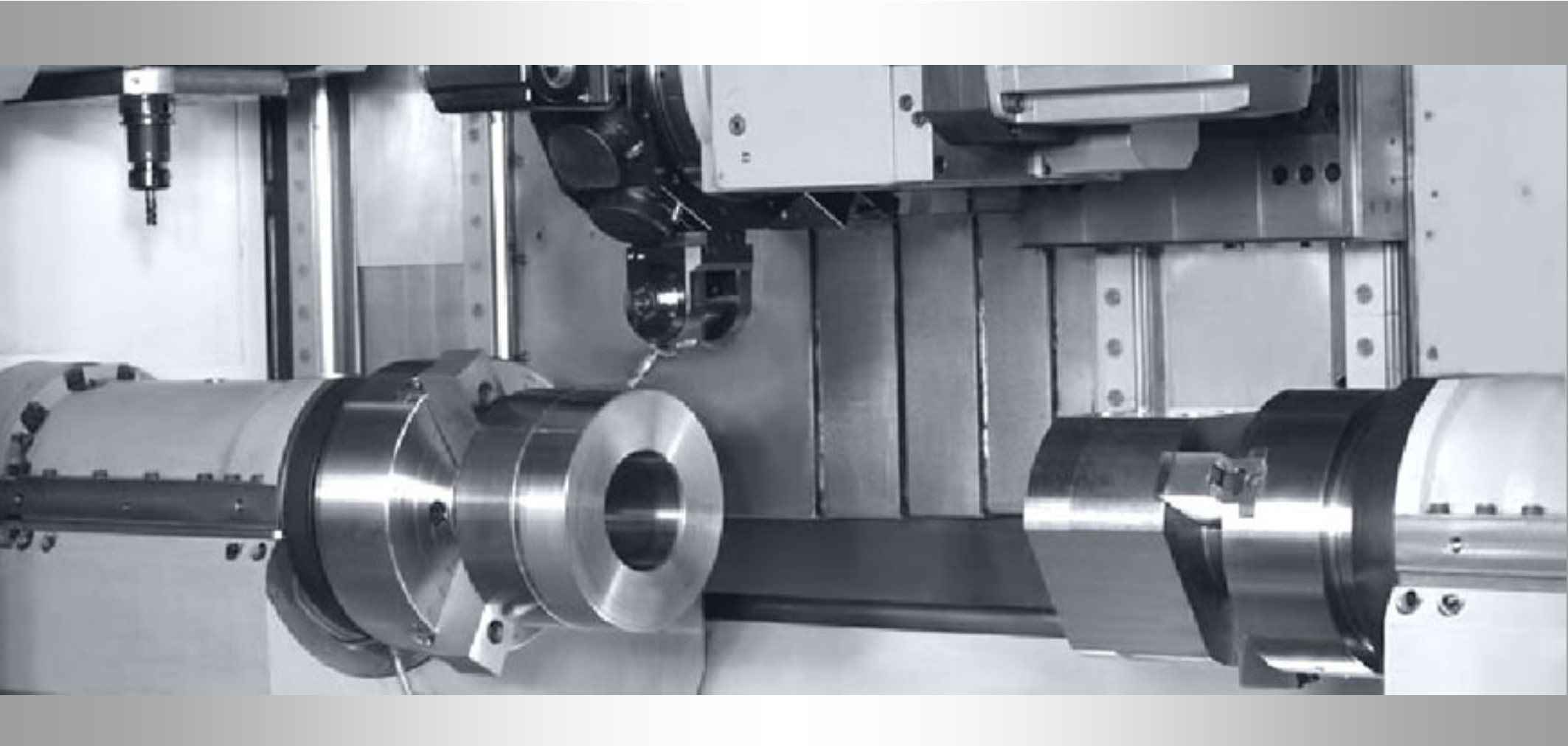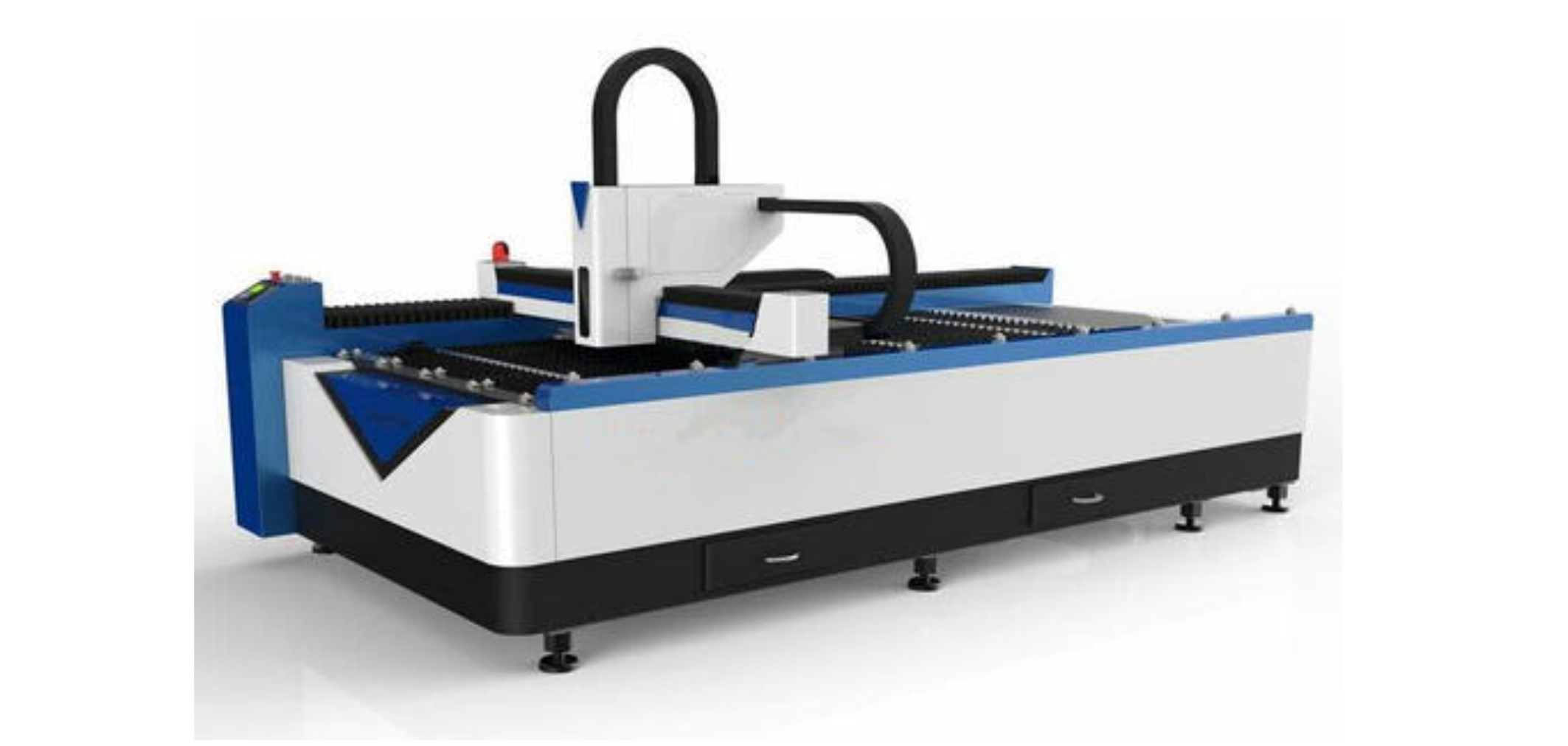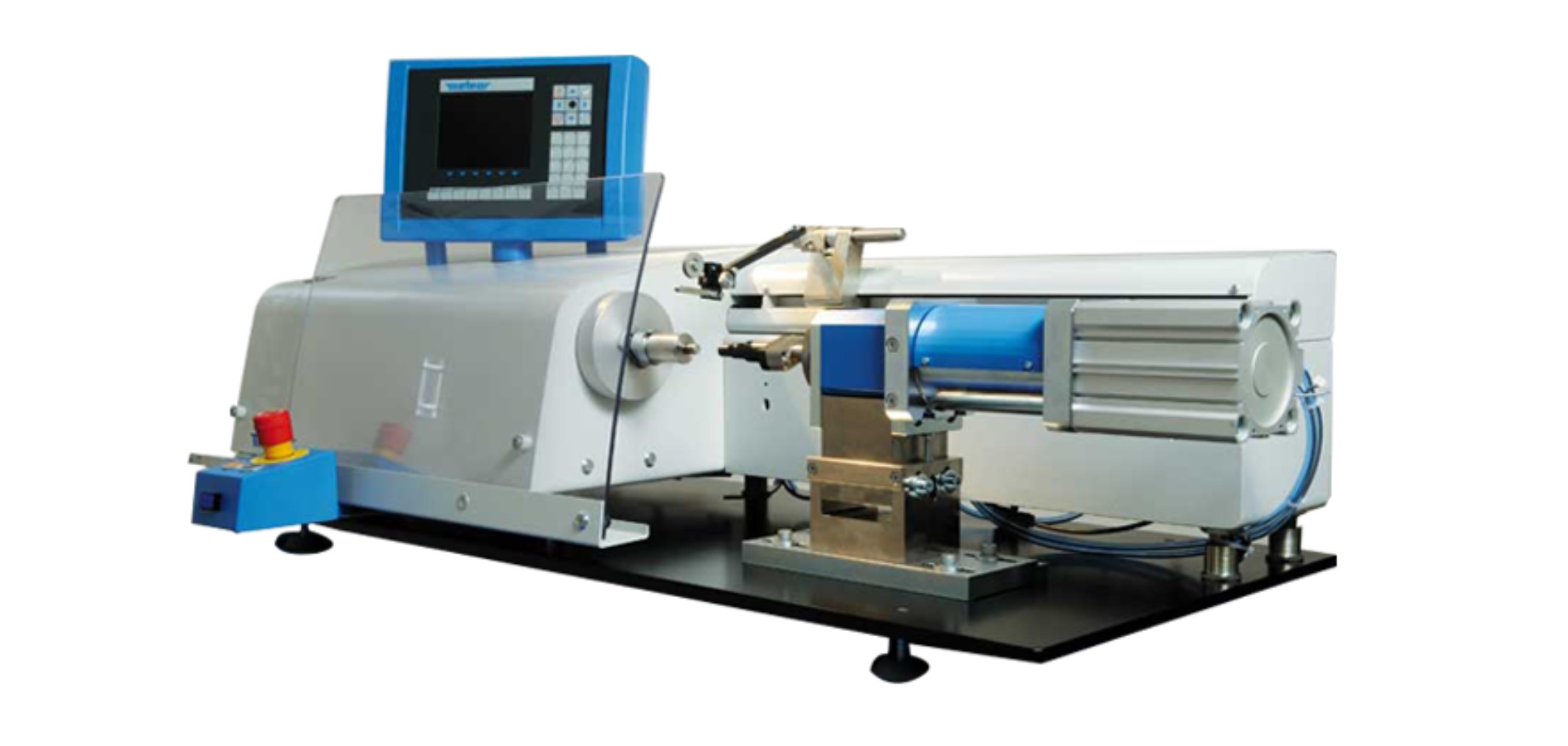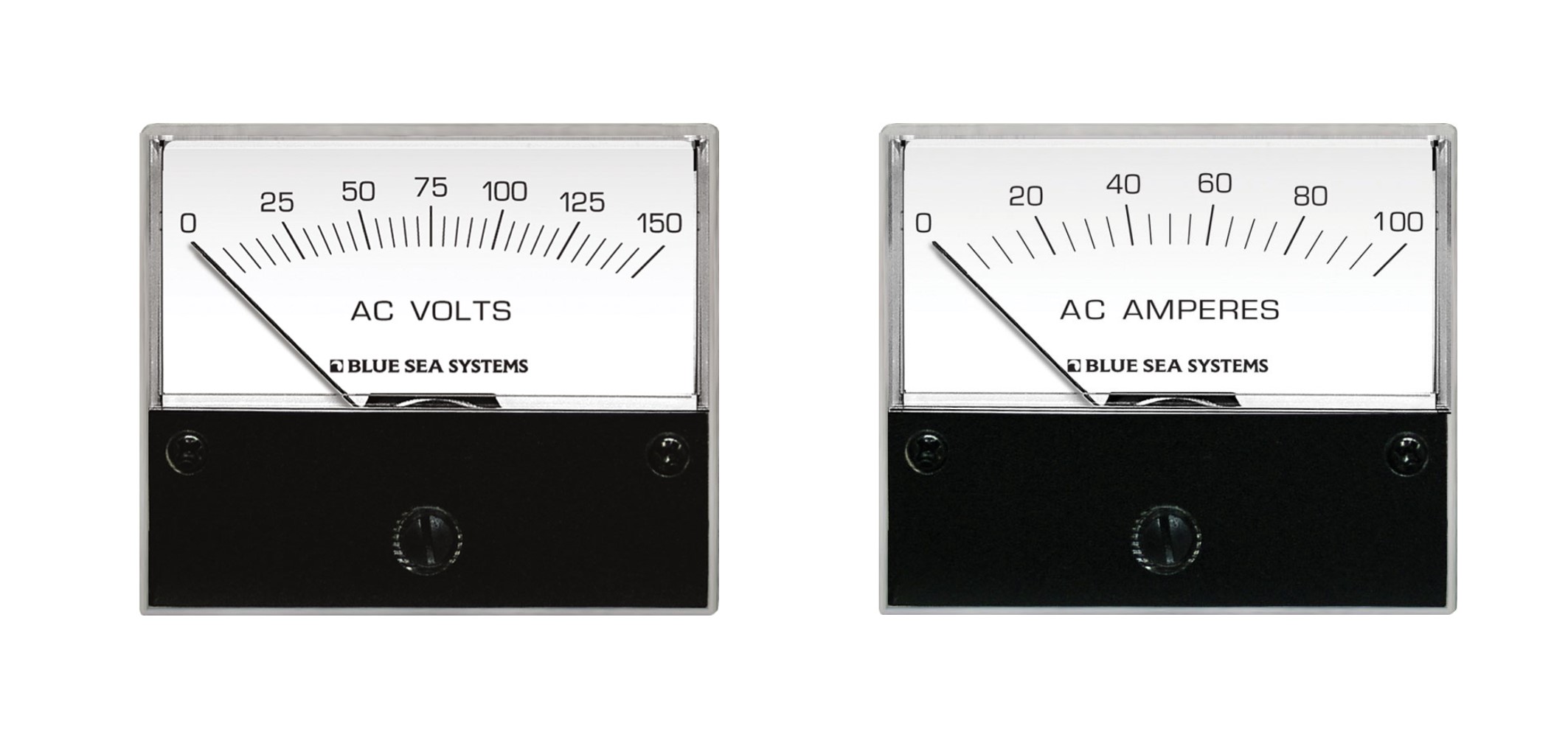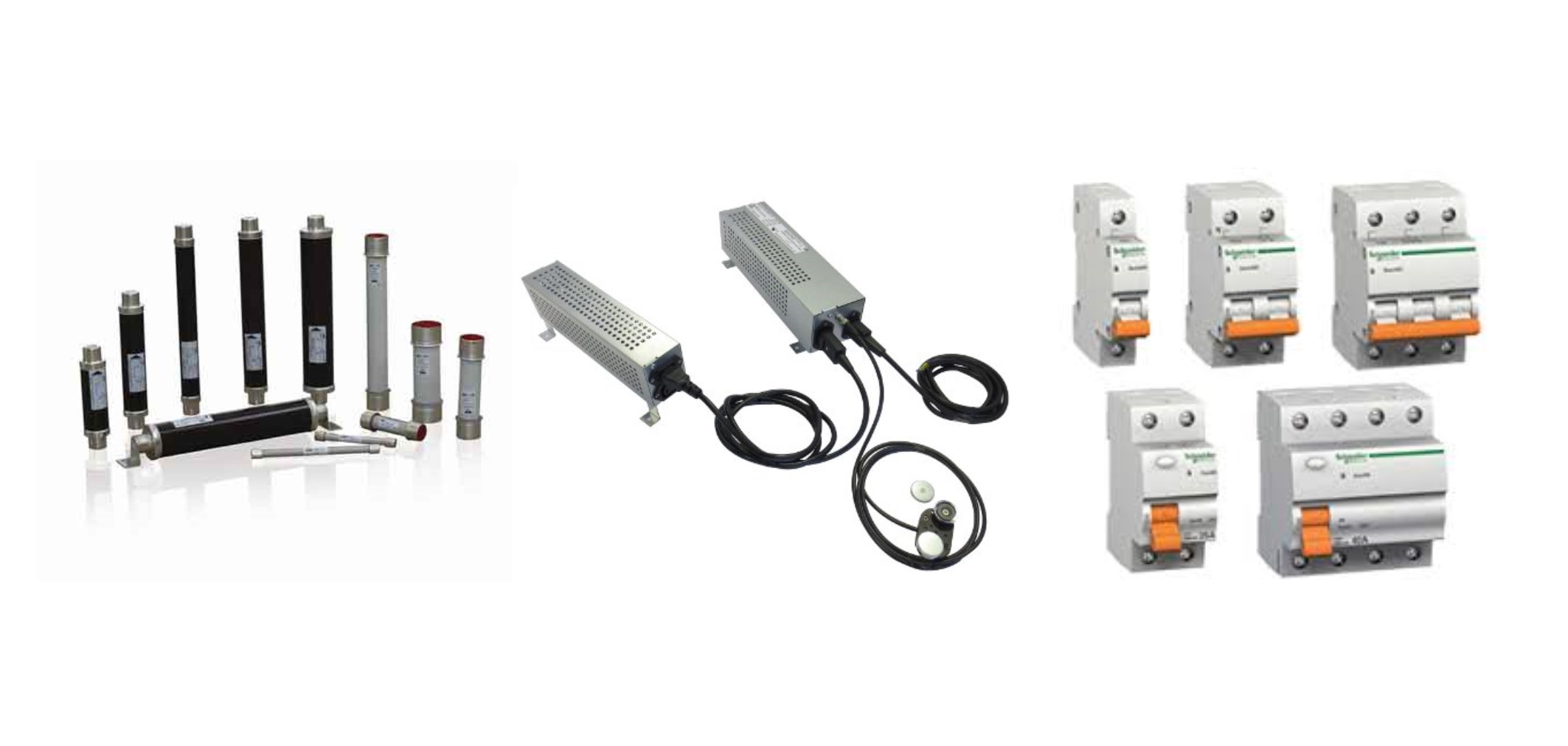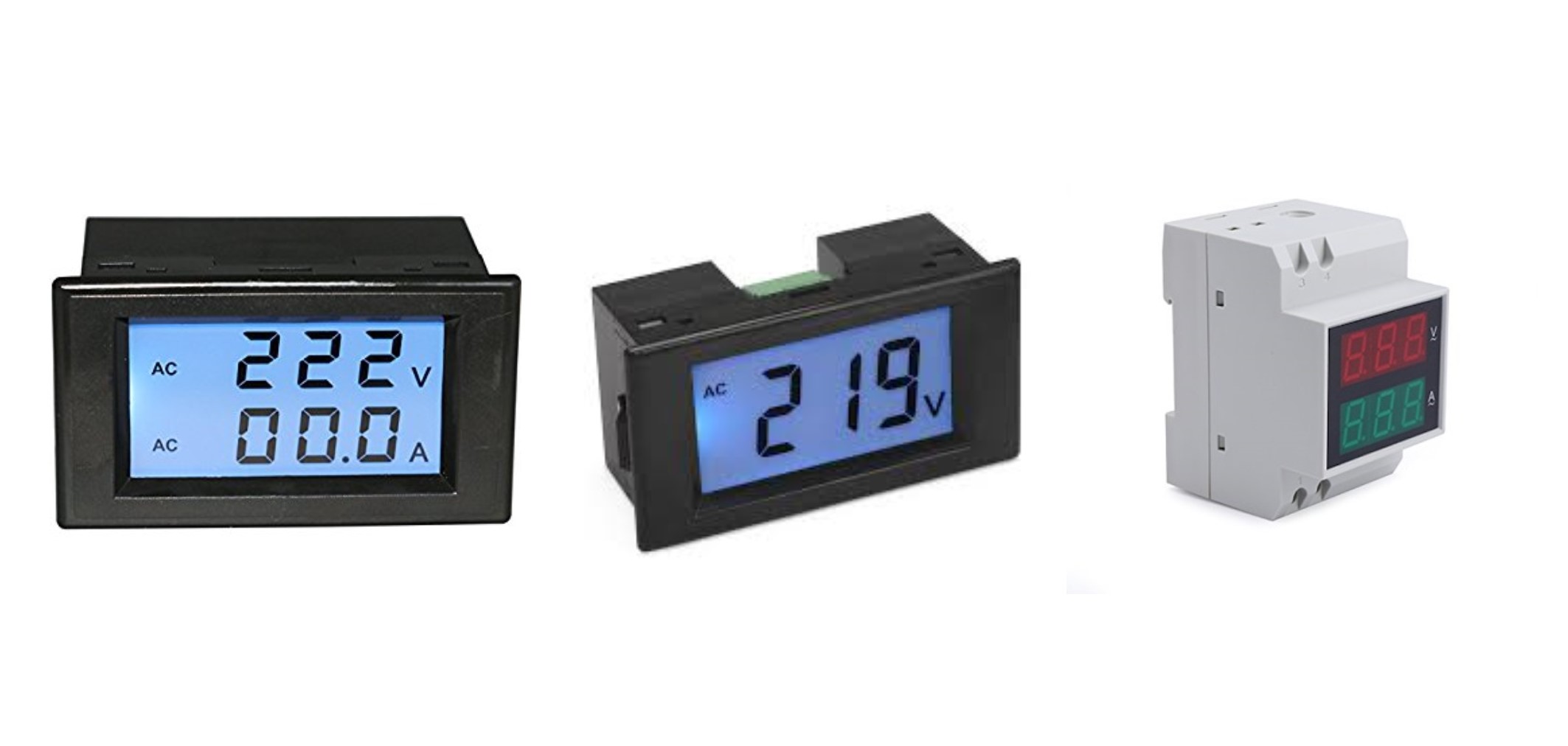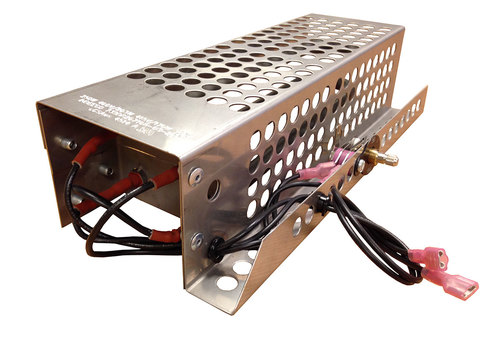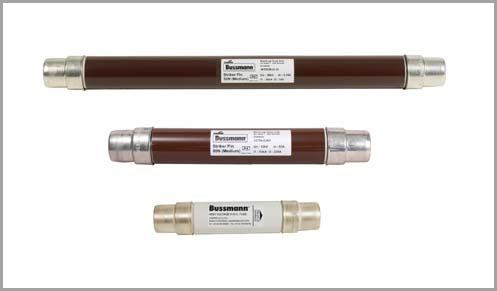If the selection of inappropriate specifications switchgears go unnoticed, it may jeopardize safety of man and machines both. Therefore, utmost care is required, while designing an electrical protective scheme as far as selection of CTs of correct specifications, switchgears, etc is concerned.
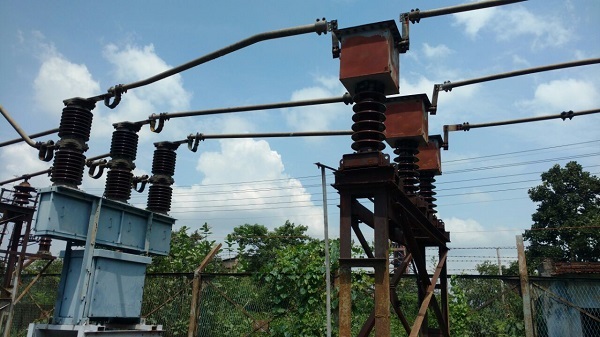
In course of inspections of the respective electrical installations, numerous discrepencies pertaining to electrical schemes of switchgears are observed. Some of the discrepencies which are observed on regular basis, are elaborated hereunder:
• Use of metering CT in place of protective type
• Connection of both metering and protective apparatus through the same CT
• Use of switchgear of improper specifications in a particular protective scheme
The above-mentioned diiscrepencies are explained below:
Use of Metering CT in Place of Protective Type
Shown in figure 1 is an electrical protective scheme known as combined over-current and residual earth fault scheme, which is usually employed in the electrical installations. As shown, the CTs continuously sense the current of circuit to be protected and feed the same to relays. The current so measured varies in magnitude and direction depending upon the type of fault.

Figure 1: Electrical protective scheme
The B-H or I-V charecteristics of metering and protection CTs are shown in Figure 2 through a common curve using blue and green shades respectively. As can be seen, the core of metering CT gets saturated nearly at the rated current of CT whereas the same in case of protection CT happens at about 20 times of rated current ( typically for a 5P20 CT). Evidently, a saturated CT doesn’t pass on the prortionate current to the relay, resulting in its failure to function even in case of a severe short-circuit in the power line, endangering safety of human beings and electrical apparatus.

Figure 2: B-H or I-V charecteristics of metering and protection CTs
A typical schematic layout is shown in figure 3 where metering CTs were being used inadvertently in place of protecticve ones and a short-circuit fault of say 2000A has occcurred in the outgoing side of circuit to be protected. The relays cease to function for want of current as against 50A of current during fault only 5A current flows through the respective relays, inadvertently making them defunct.

Figure 3: Schematic Layout
It is worthwhile to advise herewith that the appropriate CTs shall be used, particularly, in the protective circuits so as to avoid the malfucntioning of relays in the event of exigency.
Connection of Both Metering & Protective Apparatus Through The Same CT
In many electrical installations it is observed that both metering and protective devices are fed through the common CTs, making the scheme unrelaible, unsafe and ineffective in long run. An ammeter is designed to display the full load current and may carry a certain amount of over-current for a certain duration ( typically 2 to 2.5 times of rated current for about 10 sec or so). A typical scheme where both protective relays and metering devices are connected through the same set of CT is shown in figures 4 and 5.

Figure 4: A typical scheme where both protective relays and metering devices are connected through the same set of CT
During short-circuit fault, very high curent flows which may lead to open-circuiting of ammeter. The open-circuiting may also take place due to failure of Ammeter Selector Switch, connected in the protective circuit as shown. The open-circuit in the protective circuit will lead to the dysfunction of concerned over-current relay and burning of concerned CT in the long run.

Figure 5: A typical scheme where both protective relays and metering devices are connected through the same set of CT
In view of above, the metering and protective devices shall be supplied through the independent cores of a CT of appropriate specifications.
Use of Switchgear of Improper Specifications in a Particular Protective Scheme
Adoption of wrong type of protective scheme is observed on regular basis in some of the electrical installations. An electrical network with the maximum short-circuit fault level of say 25 kA found being controlloed using a switchgear of breaking capacity of say 4.5kA, may lead to burning of switchgear itself in the process of clearing the fault. A typical scheme, being used to control the frequnet start/stop of machine, is equipped with instantaneous/high-set over-current protection. The maximum short circuit current for the existing impedance of installation is measured to have a magnitude of say 12kA and the relevant relay is wired to trip the concerned air-break/vacuum /SF6 type contactor having breaking capacity of say 4.5kA. Though the relay will actuate on sensing the fault but it is certain that the contactor alongwith relevant electrical panel may burn in the processs of clearing the fault.

Figure 6: A typical scheme, being used to control the frequnet start/stop of machine, is equipped with instantaneous/high-set over-current protection.
In order to avoid incidents of above-mentioned type, it is mandatory to ascertain the suitability of relevant switchgears for a particular application.
Conclusion
Through this article, an effort has been made to highlight some of the common mistakes committed while designing an electrical protective scheme which if adopted in the initial phase and gone unnoticed, may jeopardize the safety of man or machine or both.
Avantha Group Company, CG Power and Industrial Solutions Limited (CG) through its wholly-owned subsidiary at Belgium in consortium, fabricated the largest ever Offshore Transmission Substation.
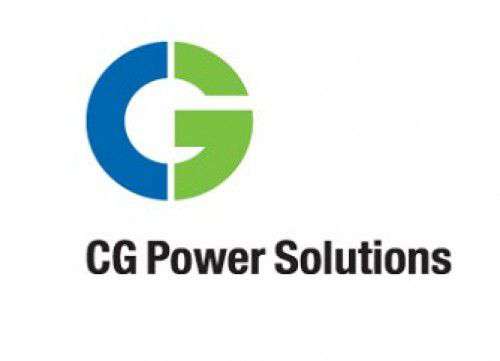
Avantha Group Company, CG Power and Industrial Solutions Limited (CG) through its wholly-owned subsidiary at Belgium in consortium, fabricated the largest ever Offshore Transmission Substation with overall electrical transmission design, manufacturing, installation to commissioning and energisation of all main power transformers, high & medium voltage equipment and control and protection systems for the electrical transmission platform. In 2015, CG along with ENGIE Fabricom and Smulders contracted to design, supply and install the offshore substation for the German utility EnBW (Energie Baden-Württemberg).
The structure is 55 metres long, 30 metres high and weighs 4500 tonnes with 3 Main Transformers and 3 Shunt Reactors. Hohe See is the largest substation built so far at the Hoboken yard. The Hohe See Wind Farm is the biggest planned offshore wind project in Germany with 71 turbines- a total capacity of 497 MW. It is expected to generate approximately 2 billion kilowatt-hours of renewable electricity per year, adequate to power 560,000 households and reduce CO₂ emissions by over 1.5 million tons per year.
On 29th May 2018, the jacket for the EnBW Hohe See Offshore Wind Farm left the Smulders yards in Vlissingen. The jacket will be installed in the German North Sea. The substation is shipped directly from Hoboken to its final destination. The journey with the Thialf lifting vessel, the largest installation vessel, took three days for a successful installation on the offshore foundation.
Commenting on the successful commissioning and installation of the project, Avantha Group Company, CG’s CEO and Managing Director K N Neelkant said, “CG was a preferred partner for the project on account of its vast experience and successful track record in providing HV/MV solutions to the offshore industry. The successful installation is yet another milestone by CG which paves way for further growth in the fast-growing renewable sector.”
Transmission of electrical energy from source to load without having any physical wired connection, i.e. wireless power transmission will play significant role in future electronics and electrical applications. This paper discusses about wireless power transmission, principles, advantages and its scope in future.
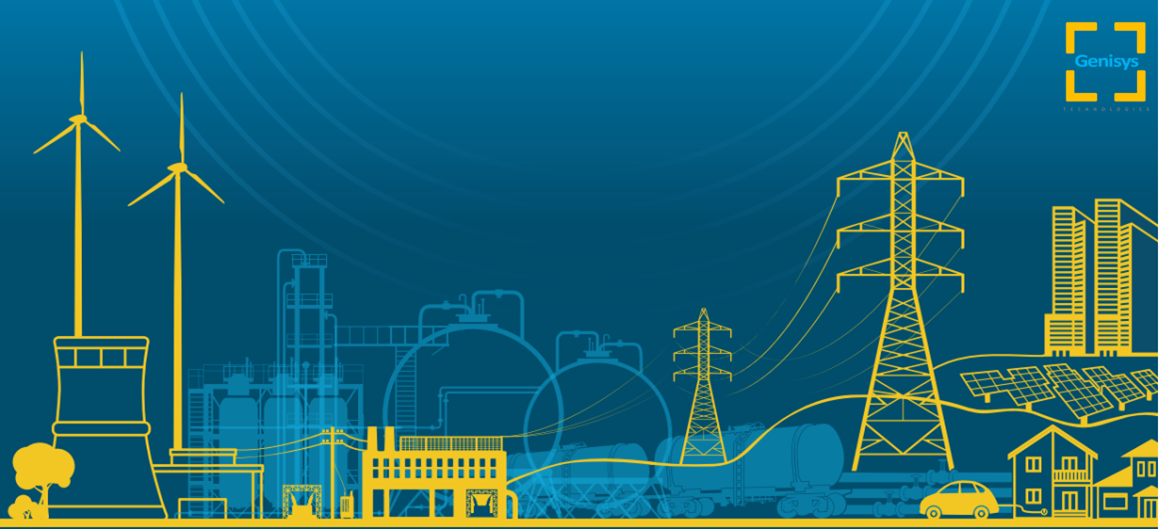
Brainstorming on WPT
There is an unsolved problem over a century, Wireless Power Transmission (WPT). It all started in last decades of 19th century, as we know, Nicolas Tesla was the first to propose and work on Wireless Power transmission. He demonstrated Wireless bulbs at World Columbian Exposition in early 1890s. In early 1961s William C Brown proposed possibilities of microwave power transmission. In 2007 a team from MIT (Massachusetts Institute of Technology) has achieved to light a 60W bulb at a distance of 2 meters with ~40% efficiency. Recent years so many experiments and advancements are being happening on WPT. Different wireless mobile chargers are results of these experiments.
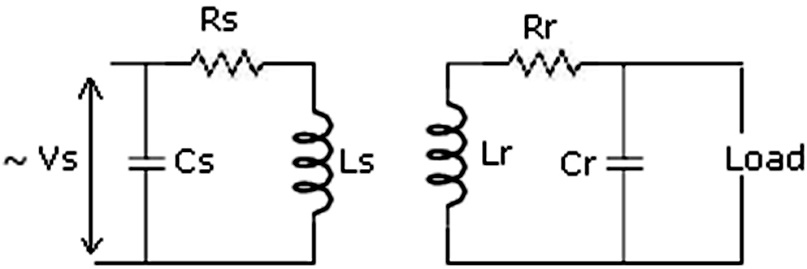
Figure 1: Simple Transmitter and Receiver circuits
Practicality of WPT
Induction Method
Induction charging usually called as wireless charging. This technology is used to manufacture wireless charges for toothbrushes, mobiles, shavers and portable devices. Wireless charging uses same principle as transformer where there is no direct connection between primary and secondary coils. Mutual induction makes the energy transfer between primary and secondary circuits. Similarly induction coil on the charger acts as primary coil and makes alternating electromagnetic field when power is supplied to it. Secondary coil on the portable device (which needs to be charged) receives power from this electromagnetic field when it is placed on the charger and converts it to electrical current and charges the battery. This amazing principle is applied to charge devices with very small range.
It is advantageous as there are no hazardous conductors are exposed, so no risk of electrical shock and it is convenient and safe. Same principle with resonant inductive coupling can be used for power transmission. Resonant inductive coupling increases the transmission range. Here, primary and secondary coils resonate at same frequency. Electricity given to the primary coil produces oscillating current generates oscillating magnetic field and is picked up by secondary coil which is converted into electricity for the load.
Another type of coupling capacitive coupling or is electrostatic induction. Principle is capacitive coupling between two or more electrodes or plates with high frequency, high potential AC current.
All above principles are limited to small distances. These technologies can’t be implemented for larger distances.
Microwave Power Transmission
Through this method power can be transmitted over greater distances. William C Brown demonstrated wireless power transmission through microwaves using Rectenna in 1964. Rectenna is an antenna with rectifier device. Microwave power transmission gives us feasibility of directional power transmission. Typically, this system contains microwave transmitter which generates microwaves using an antenna. Receiver contains a Rectenna which converts microwaves back to electricity. One of the major obstacles with this method is it needs very large scale antennas.
Laser Beam Power Transmission
This method uses photovoltaic cells, which converts light into electricity by photovoltaic effect. First power is converted to laser beam and transmitted from the source. Photovoltaic cells are used at receiver. These cells are used to convert laser beam back to electricity by exposing them to laser beam. Laser beams cross section is very less and it is advantageous for transmitting over larger distances, but laser beams are dangerous to humans and animals. Other disadvantage is it is highly directional receiving photovoltaic cells should be exposed to the transmitted laser beam otherwise complete loss of power could happen. Atmospheric absorption, environmental scattering effects, weather difficulties could affect the efficiency of this system.
Trends and Future of WPT
There are number of technologies for transmitting electric energy from one point to other for shorter distances. Inductive coupling is most commonly used technology for very short distances in mobile charging as discussed.
Recently one of the major mobile manufacturers has filed a patent for scheduled charging of its appliances. Reportedly it is RF based wireless power. It makes an impact on wireless charging mobile devices. It would irk its competitors to do R&D on futuristic wireless charging facilities. Energy square developed a conductive wireless charging. A strip with two conductive points is used to charge mobile. Mobile is placed on top a pad which is connected to power source to charge.
Future mobiles could be charged with mobile service provider, delivering required power from mobile base station. Mobile inbuilt software and hardware takes care of energy threshold level to charge from base station. Higher efficiency is possible with proper handshake between mobile and service provider’s base station. No need to carry a charger or a power bank. Mobiles adopt such change, and soon charging devices become history.
Trends are towards wireless charging points at signals for Electrical Vehicles. In order to minimize carbon footprints, EVs are being replaced with petroleum product vehicles. Charging EVs while driving for longer distances is obstacle to replace existing vehicles. Special roads are to be constructed across utilities and maintained with inductive coupling to provide continuous charging for EVs. Each EV is identifiable from source perspective. Alternative charging possibilities are being researched to construct roads for continuous charging for EVs.
Wireless power plays major role in life saving departments in future. Remote power is a demanding requirement for hurricane prone areas. Quick recovery is possible with wireless power and also it is possible to stop major equipment damage from such disasters. Remote power receivers dug into earth when hazard level meets threshold. Later raises and receives energy and distributes it to required load.
We are not far from wireless power transmission and distribution with high efficiency. Utilities have to take step on it as it has advantages over wired connections.
Advantages of Wireless Power
Wireless power is future and will replace existing wired communication of electricity. Some of the advantages are listed below:
- Power can be transmitted to remote areas where wiring is not feasible.
- Wireless power is not hazardous as wired power where conductors are exposed.
- Transmission and distribution losses of existing system can further more decreased when high efficiency wireless power transmission is implemented.
- Electric vehicles can be charged from anywhere.
- Advantageous to customers is they can be free from power cords, plug in cables and plug in adaptors.
- Expenses on transmission and distribution assets can be reduced, and maintenance costs on transmission and distribution assets can be mitigated.
- Devices can be free from chargers as devices can be charged from anywhere.
- Secure from power theft with handshake from source to load.
- Market enhancement with possibility of welcoming more power vendors to larger distances and customer choice of selecting the power vendors when more power vendors enter into the market
- Market based prices can be applied on power when more vendors are participated in the market.
Efficiency is one of key factors to consider in WPT. Still the problem which Tesla tried to answer is not answered yet. Transmission and distribution of electrical energy with utmost efficiency is not practically implemented. High capital cost and interference are also considerable points to make commercial implementation of wireless power over long distances. More researches required having wireless power system with safe, secure, high efficiency and optimal capital cost as it has so many advantages. As technologies are growing, it is possible to see complete wireless power in future and that day is not too far.
Since solar energy has gained worldwide acceptance due to its feasibility, easy to install, and reliability, solar energy growth and EV growth have become interconnected. By Supriya A Oundhakar, Associate Editor
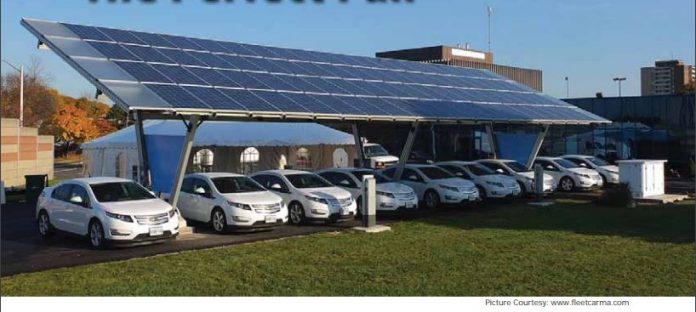
Global transport system is witnessing a rapid transition due to burgeoning global CO2 emission levels and commitments to decarbonisation as the transport system is one of
the factors responsible for deterioration of environment. The transport system, being the biggest consumer of crude oil, is responsible for greenhouse gas emissions and thus, it is making a switch to green energy utilisation worldwide.
Following in the footsteps of Germany and China, India is also focusing on the growth of electric vehicles (EV) depending on solar. India, being the world’s second largest two-wheeler market, fifth largest photovoltaic (PV) market and seventh largest commercial vehicles market, has set the target of 30 per cent adoption of current electric vehicle new sales of electric passenger cars, light commercial vans, buses and trucks by 2030.
EV Future Driver of PV
EVs have started gaining momentum due to its energy efficient and environment-friendly nature. Use of solar energy for charging EVs has emerged as the cleanest energy option having zero carbon footprint. Since solar energy has gained worldwide acceptance due to its feasibility, easy to install, and reliability, solar energy growth and EV growth have become interconnected.
While taking note of this emerging trend, Awadhesh Jha, Vice President-Charge & Drive & Sustainability, Fortum India, states, “Though various research and study has proven that despite use of fossil fuel, EV is cleaner than ICE (internal combustion engine) vehicles,
it would be prudent if EVs are powered by renewables likes solar. It will spur the demand for more cleaner energy and that will be provided by PV as it has become quite affordable. In fact, PV and EV are supplementing to each other. With much lower price of solar energy, operating cost of EV will be lower which will create more demand for EV which in turn
push for more solar power.”
He adds, “More and more PV getting added to the system will create imbalance in the grid requiring to be stabilised by some form of storage. Battery EV provides good storage system to PV which again boosts the deployment of PV.”
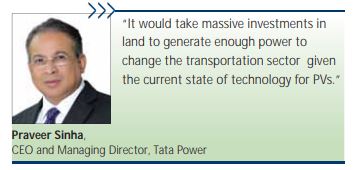
Technological innovations can make PVs more efficient, leading to e-mobility to be the growth driver of solar. According to Praveer Sinha, CEO and Managing Director, Tata Power, “The technologies, both in terms of EVs and PVs, are evolving as we speak. So, until there is a technological breakthrough that significantly improves the quality of power generated from PV panels that is enough to run an automobile, the demand for PV will be driven by the inevitable growth in EV offtake.”
Going ahead, in 2017-18, India’s crude oil imports witnessed a jump ballooning its import bills to US$ 87.7 billion. Further, the transport sector is the biggest consumer of crude oil with usage of 70 per cent of diesel and 99.6 per cent of petrol. To this, Ivan Saha, BU Head Solar Manufacturing & CTO, Vikram Solar states, “Understanding the threat to India’s economy, pollution, and convenience, the Government of India is focusing on EV market growth depending on renewable energy (especially solar) to save billions of forex outflow, and reduce dependency on fossil fuels. With countries waking up to realise the potential of
green energy transition of transport market, e-mobility will undoubtedly drive the PV market globally.”
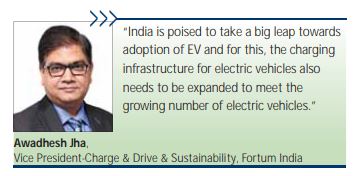
As per a NITI Aayog report, India can save 64 per cent of energy demand for road transport and 37 per cent of carbon emissions by 2030 by pursuing a shared and connected electric mobility future. Worldwide, the industry is gearing up to lower carbon
dioxide emission targets over the next decade, especially, through the use of renewable power generation techniques. The move to EV is necessitated by the urgency to curb the current account deficit by cutting down on oil imports. This will reduce India’s dependence on oil-rich countries, opines Simarpreet Singh, Director, Strategy, Hartek Group, and FounderDirector, Hartek Solar Pvt Ltd.
Bumpy Ride Ahead
Though electrification of transportation and the use of solar-powered charging stations as an electricity source will ultimately improve people’s quality of life, its penetration in India is likely to remain low due to the challenges like charging infrastructure and battery technologies. According to Simarpreet Singh, as of now, storage solutions in India in the form of lead acid batteries are very expensive. The next critical technology for e-mobility and rooftop solar in India is the development of more cost-effective and efficient batteries which can store electricity when generation is at its peak and meet the requirements of users during peak demand hours.
Moreover, land availability is also one of the stumbling blocks posing in the way to e mobility. Praveer Sinha is of the opinion that it would take massive investments in land to generate enough power to change the transportation sector (personal and commercial) given the current state of technology for PVs. This challenge will be even more acute in
cities where land costs can be forbidden to warrant the creation of a solar powered charging infrastructure.
According to Ivan Saha, people are often concerned about range of EV. Enough number of charging infrastructure is required to keep this from becoming a reason behind failure of EV.
Although, the Government of India is working to promote EV development, there are challenges in establishment of charging infrastructure:
Research shows that India has nearly 350 renewables public EV chargers, while the number of petrol stations stand at 57,000. While comparing with China, it has installed around 2,15,000 charging points at the end of 2016. In the same breath, we can point out that if Solar panels cover 0.5 per cent of Rajasthan, can generate power for 330 million EVs. Delay in installing more solar charging stations is keeping India’s first EV procurement plan in limbo.
Electricity Act forbids companies without distribution license to sell electricity. This restricts development of charging infrastructure. Currently, the government is taking steps to implement the charging as a service model to aid in EV adoption.
One of the reasons for lack of charging infrastructure is confusion of charging standards.
India has recently decided to back off from implementing an EV policy, thus paving the way for the market to decide on charging standards and keep pace with the global technology advancement.
In India, DC fast charging would be the main charging mode for EV as Indian urban areas do not have majority of single family house which would provide charging overnight facility. A DC fast charging would need higher load at continuous level. To meet this load requirement of charger, an in-situ solar plant needs to be designed as it has characteristic to supply to its full load only during few hours of the day. This combination makes the solar powered charging station not affordable for EV as one of the hallmarks of EV is its low operating cost. This has to wait till the time efficiency of solar panel increases substantially
necessitating lesser area need, suggests Awadhesh Jha.
E-mobility Wave
The e-mobility wave will gather more steam in the near future in India as EVs are the way forward for a clean world. For this, India is gearing up to ride this wave by enrolling e-charging technologies and highly efficient lithium ion batteries. It is also possible that in the initial phase of this wave the adoption rate will be higher in the public transportation space. Further, the rapid expansion of charging infrastructure will be essential to drive the e-mobility wave, even as auto makers continue to make the vehicles more efficient and offers higher range per charge, observes Sinha.
Electric vehicles and residential or commercial solar power charging stations can serve and aid growth of each other. With solar energy becoming mainstream energy source worldwide, potential for EVs using solar energy is high. It is estimated that India’s energy import bill will rise from $150 billion to $300 billion by 2030. Keeping this scenario in mind,
Saha avers, “It is fair to say that the country’s shift to solar power generation and EVs is the best and actually, the only move left. Considering India’s focus towards EV growth through policy development and investment, Vikram Solar has elaborate plans to
contribute to India’s e-mobility growth.”
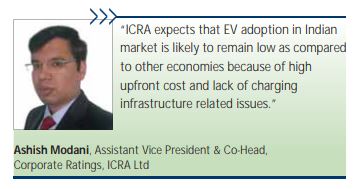
The success of e-mobility in India will largely depend on upgraded grid infrastructure to cater to an electricity demand of 100-120 Gwh for powering an estimated 65-75 million electric cars, buses and trucks by 2030. The automobile manufacturers are investing billions in conversion of its product ranges to ride the e-mobility wave.
Fortrum has plans to set up charging infrastructure in India and are evaluating several locations. Jha opines that all parking places must have minimum 20 per cent of parking earmarked for charging station. These locations could be used for DC fast charging. The earmarked parking spaces should be given free of cost to potential charging service provider initially for couple of years. Alternatively, the Government can adopt Transport for London (TfL) model in developing charging infrastructure where TfL secured sites and provided upgraded electricity grid infrastructure.
Moving ahead, in 2018, Government exempted e-vehicle charging station from licencing requirement for charging EV batteries. This step will help in entry of new players or third-party service providers in setting up charging infrastructure, concludes Ashish Modani, Assistant Vice President & Co-Head, Corporate Ratings, ICRA Ltd.
The development of rooftop solar projects makes considerable sense for commercial segments as the levelised tariffs are significantly lower than grid-based tariff. These segments are, therefore, driving growth in the rooftop solar space, followed by the government & institutional segments.
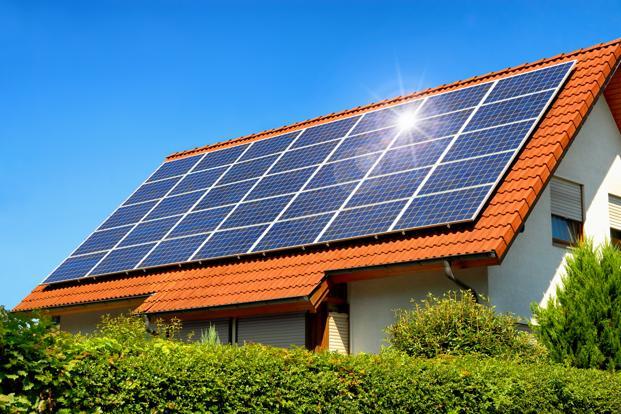
Renewable energy contributes about 20 per cent to India’s installed capacity. Although conventional fuels still dominate this segment, the share of renewable sources has been steadily increasing from about 10 per cent in 2009. This growth has been fuelled by the increased availability of renewable sources at competitive costs near industrial demand centers, declining capital costs of equipment, and rising grid tariff of industrial and commercial consumers. Measures like preferential tariffs, accelerated depreciation, generation based incentives, third party power sale option, provisions for the banking and wheeling of power, concessional loans, and prompt clearances have also played a crucial role in promoting the renewable power segments growth.
The climate change threats are driving our dependence on pollution-free sources of energy to minimize greenhouse gas emissions. Solar PV energy is one of the cleanest sources of electricity and is being considered as next to fossil fuel based conventional electricity systems. India has set its renewable energy capacity addition targets to 175 GW by 2022 in view of the significant renewable energy potential in the country. This includes 100 GW from solar, 60 GW from wind, 10 GW from biomass and 5 GW from small hydro power. Solar photovoltaic rooftop has emerged as a potential green technology to address climate change issues by reducing reliance on conventional fossil fuel based energy.
With a strong commitment to increase the renewable sourcesbased energy capacity, India has a target to install 100 GW of solar energy capacity which includes 40 GW from solar rooftop. Some of the electricity demand will be met locally through these rooftop solar installations, leading to less requirement from the grid. For players that need smaller capacities, rooftop solar is an attractive option. Another upside is the additional revenue that rooftop solar can derive from the sale of surplus power to the grid. It is also used to
fulfill the renewable purchase obligation of distribution companies.
Most of India’s installed solar capacity is ground mounted with rooftops accounting for only a little over 7 per cent of the total. However, the government is making concerted efforts to promote this segment with 40 GW by 2022 target being planned on rooftop. The countries’ total installed rooftop solar capacity has crossed 2 GW. A number of states have come forward to support the centre’s plan and are encouraging rooftop solar plants based on net metering. Such projects are quick to implement and offer stable and fast returns. Solar rooftops are gaining relevance in the energy security plans of small, medium and large scale industrial users. However, with a number of positive policy and technology developments taking place, the pace of installations is expected to pick up. With favourable project economics, a progressive regulatory scenario and easier availability of finance, segment growth is clearing picking up.
Development of Rooftop
World cumulative installed solar energy capacity was 3.7 GW in 2004 has reached 177 GW in 2014 i.e., increasing almost 50 times in ten years. Over the past two year, there has been a strong impetus to rooftop solar, which has resulted in a sharp increase in installed capacity. The rooftop solar segment grew by 80 per cent in last two years over FY 2015-16. As opposed to other rooftop-rich countries that have grown on the back of high capacity additions in the residential rooftop segment, the Indian market has seen greater growth in the commercial and industrial rooftop solar segments. As of March 2018, the total installed solar power capacity in India stood at 21.6 GW, of which 9.6 GW was added in FY 2017-18.
As of March’ 2017, the installed rooftop solar capacity in India was stood at 1.40 GW and it has touched 2 GW in 2017-18.
Maharashtra is the largest rooftop solar state in India in terms of installed capacity followed by Tamil Nadu, Rajasthan and Karnataka, while Uttar Pradesh, Andhra Pradesh and Punjab lag far behind the target. Uttar Pradesh and Andhra Pradesh are among the nine states that have a policy for gross metering in addition to a net metering policy. Almost all utilityscale developers have jumped on to this bandwagon, assigning separate terms for establishing their solar rooftop businesses. In the past one year, number of engineering, procurement and construction companies have entered into this market, mostly concentrating on different regions in the country. As far as the policy framework is concerned, all the states have announced their net metering policies for rooftop solar, which is noteworthy.
Solar Rooftop PV Design
A solar photovoltaic power plant consists of different components i.e., photovoltaic modules, mounting system, dc–ac converter and electrical connections. The Rooftop PV systems are smaller PV systems in comparison to land mounted ones, installed on rooftops of residential, commercial or industrial building complexes. It comprises of solar inverter, meters for regulating electricity generated and various components for modification of electrical output and input rate in kWp. The electricity generated from such systems could either be entirely fed into the grid at regulated feed-in-tariffs, or used for self consumption with the net metering approach.
Rooftop solar PV installation technology in urban or rural areas requires intervention for (i) Grid connected solar installation; (ii) Solar system synchronised with diesel genset (iii) Off-grid solar installations with battery back-up. Designing of rooftop solar according to local conditions is the basic engineering skills required. Methods must be devised to capture low radiation energy and converted into actual power for optimisation. A good design would integrate the location specific parameters with rooftop solar PV system. Full potential of non-grid Rooftop PV is yet to be utilised as due to high cost. With part financial support provided by the state to promote their use, such systems are considered the most appropriate for rural and remote areas. In the regions of power shortages, performance reliability of non-grid rooftop PV can also be improved with back-up battery and this helps in bringing down the cost.
Need for New Business Models
High capital cost of Rooftop Solar system which is estimated approximately Rs. 75,000/kW has been a key challenge for its adoption by the industry or small consumers. The payback period is 6 to 7 years and 9 to 10 years in commercial and residential sectors, respectively. The success of Rooftop Solar system, therefore, remains dependent on new business models evolved from time to time to overcome the cost barrier. At present three types of business models are envisaged.
i. Self owned, the roof owners own the PV system and generates electricity. It is called CAPEX (capital expenditure) model and the risk is of the owner who invests in the system. ii. Third party ownership, in which third party or a developer bears the cost of solar rooftop and sells to customer at a rate lower than grid tariff. This is called OPEX (operational expenditure) model because developer which is also Renewable Energy Service Company (RESCO) pays for the system for specified number of years and also owes the risk. Third party investment model has only 10 per cent share at present. It is yet to pick up because of high contract default risks arising from rapid declining cost of solar energy.
iii. The third is Lease model in which customer leases the system and pays for it overtime. This type of arrangement may suit multi-storey flat owners but not yet come into existence.
To make solar Rooftop Solar system an attractive proposition, Indian Renewable Energy Development Agency (IREDA) is joining hands with banks and multilateral financial institutions to provide soft loans for development of solar rooftop system.
Policy Initiatives
In its efforts to encourage the implementation of rooftop solar projects, the government has rolled out a number of schemes and regulations. In 2015 Government of India has considered increased provisions of funding for implementation of grid connected rooftops over next five years. The subsidy of 30 per cent announced to all states and up to 70 per cent to special category states. The commercial and industrial sectors are made eligible for accelerated depreciation, custom duty concession, excise duty exemption and tax holidays. The Sustainable Rooftop implementation of Solar Transfiguration of India (SRISTI) scheme the Ministry of New and Renewable Energy to target residential rooftop owners. Under this, the government has earmarked Rs 235.5 billion as financial assistance to be given for rooftop solar installations to discom on a performance basis. To address the quality issues associated with installations, the MNRE has also come up with standard for grid connected and off grid rooftop solar projects. In addition, the MNRE has brought battery energy storage systems under the purview of the solar photovoltaic systems. This will be beneficial for the rooftop and off grid segments as many consumers rely on batteries to meet their peak load and regulate the photovoltaic module output.
Following the trend set by the Central Government, the state agencies have also announced their own schemes for improving rooftop solar deployment to meet their renewable purchase obligation. The Uttar Pradesh Government provides a subsidy of Rs 15,000 per kW for rooftop solar projects in the state, this amount would be capped at Rs 30,000 for projects exceeding 3 kW. Added to that, a financial subsidy of 30 per cent or Rs 21,000 per kW could be provided by the center to the state. In Assam, a 70 per cent financial subsidy will be given for projects under its programme to develop 14 MW. Jharkhand has a programme to provide a 30 per cent subsidy, with additional 20 per cent subsidy for rooftop solar installations by educational institutions on their campuses. The other states have also announced subsidies on rooftop solar installation.
Net Metering
It is often said that one of the best way of popularising adoption of rooftop solar is by making net metering policies cohesive and also allowing users to sell surplus electricity to utilities. Net metering is helpful because the excess power is harnessed and used elsewhere and the source consumer gets equivalent benefit on his tariff or power consumption. A strong net metering policy not only helps in increased consumption of power generated by rooftop solar but also encourages its faster adoption among corporations and institutions once they see reduction in their operational costs.
One of the biggest challenges around net metering has been involvement of various agencies and multiple approvals leading to inevitable delays in implementation. Other challenges include lack of uniform regulation across the country, caps on energy that can be returned to the grid at an absolute number of KWs without regards to class of consumer, reluctance of distribution companies due to anticipated revenue loss and lack of understanding on part of implementing agencies of net metering as a concept for being an enabler for residential rooftop solar. In most of the states, the officers of distribution companies are not aware of the policies and they don’t have the required infrastructure to record and give benefits of units exported to grid. Addressing these issues in a time bound manner in relation to the yearly targets envisaged will help give thrust to the adoption of net metering as a key tool to achieve the overall growth of rooftop solar. There is need to build infrastructure for net-metering and also educate all concerned so that net metering can be implemented.
Challenges
As against Ministry New Renewable Energy (MNRE) target of 5 MW in 2017-18, cumulative rooftop solar capacity touches 2 GW as on March’ 2018, with less than 5 per cent of the 40 GW rooftop solar target to be achieved by 2022, it is clear that there are bottlenecks on the supply and demand side that are posing significant challenges to the segment’s growth. On the supply side factors such as lack of debt financing, high customer acquisition costs, low entry barriers, resulting in inexperienced players entering the fray, and focus on capital expenditure over operational expenditure by service providers have led to the situation. On the demand side, factors such as heavy focus on commercial and industrial entities, exclusion on residential sector, lack of consumer awareness, lackadaisical movement on net metering, and moderate tendering activity due to multiple stakeholder involvement appear to be the key reasons for the slowdown.
While the government has introduced some growth-enabling policies, their implementation has run into many challenges and operational issues. Different land and infrastructure agreements have different duties levied on them, instead of a stamp duty in some states. The goods and service tax (GST) for the solar segment has been the subject of discussion in last year. There was a major debate about taking modules at 5 per cent or 18 per cent, before it was finally settled at 5 per cent. There is also ambiguity regarding the GST for balance of system equipment. While GST has been specified for a few components such as inverters, the rates for remaining parts remain ambiguous.
A developer’s primary job is to set up a plant and produce power, instead of going to the judiciary to settle legal and regulatory issues. In addition, any changes in law will only lead to legal completions, thereby, delaying project development. Therefore, there should be greater certainty regarding the regulatory regime. The main barriers faced during large scale deployment of solar rooftop PV include lack of awareness among consumers about the system, lack of manufacturing facilities, lack of skilled workforce, high upfront cost and lack of business models and regulatory challenges.
Consumer Awareness & Acceptance
Consumer awareness about the rooftop solar PV and its market acceptance is the most significant challenge in promoting solar energy, which is having a social bias. The consumer not only has greater affordability and awareness about the consumer rights, but also is facilitated with dynamic policy instruments which are consumer friendly. In developing countries people are less aware of the government policies and the available incentives. Being cleanest source of energy its climate change imperatives are not fully understood. There is need of Consumer guidance centers to educate about placement and function of meters, process for metering and interconnection with grid as well as maintenance are needed so as to achieve the potential target of rooftop solar. Nodal agencies in respective states may play a vital role in this regard
Way Forward and Recommendations
For development of rooftop solar, the central and state governments have done good job on solar rooftop policies, incentive mechanism, recommended changes to the net metering rules and plant size specifications to accelerate solar rooftop. Since last year, many uncertainties have disrupted growth momentum like fluctuation in PV model prices, bottleneck in implementation of net metering and uncertainty in policy on the implementation of unviable duties. Many government agencies including Solar Energy Corporation of India had tendered mega projects for subsidies and incentives for residential, social and government sector rooftop installations. Further, there is substantial reduction in capex on the rooftop solar. A lot is still required to be done to promote and educate private sector for rooftop solar installation.
Net metering and a package of incentives to utilities are no doubt necessary foundations. Means of covering investors risk and greater consumer awareness can be the basic building blocks. Skill development, maximising rooftop spaces and mandates to support the adoption of rooftop solar can lead to a sustained growth.
The rooftop solar power market needs to gain traction in order to achieve its targets. The thrust, however, must come from policies that look to simplify the approval procedures through single-window clearances. The financial subsidies should be removed for the C&I consumer segments and the market should be allowed to grow on its own in order to create a sustainable ecosystem. A framework for development of rooftop solar system plus storage technology also need to be developed to enable better offtake of power and innovative methods of finance must be introduced to lower the cost of capital.
While strong foundations are being built in India through net metering policies and revising package of incentives; at city level greater role of municipalities in amendment of building by-laws for considering solar rooftop structure as temporary structure so that it does not need fresh approval for raising height of the building and role of DISCOMS in providing reduction in electricity bills by selling at lower rate in proportion to higher wattage achieved from solar installation so as increase home owners’ contribution in energy security for 24×7 power for all are being considered. Provisions are also needed for soft loans, tax credits in property and investment. It is also proposed to make solar rooftop mandatory for properties with connected loads greater than 20 kW.
Conclusion
The development of rooftop solar projects makes considerable sense for the industrial and commercial segments as the levelised tariffs are significantly lower than grid-based tariff. These segments are, therefore, driving growth in the rooftop solar space, followed by the government and institutional segments. Urban homes and residential societies, however, have not been as enthusiastic owing to the lack of awareness as well as the high upfront cost of these projects.
In this article , The power sector is reviewed with specific focus on transmission and distribution systems losses.
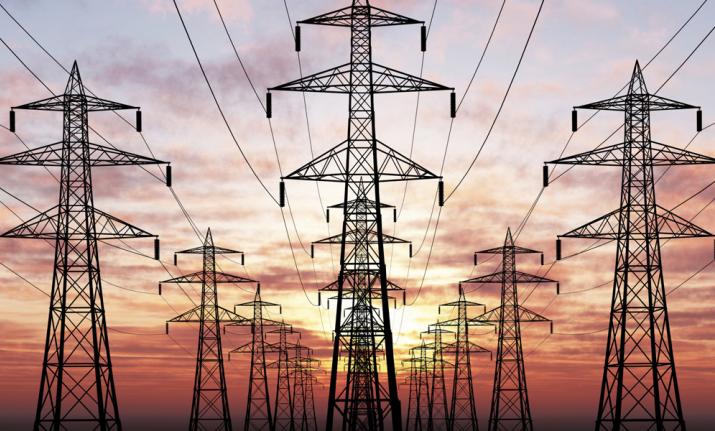
Transmission & distribution (T&D) losses are percentage of energy lost in power grid in the process of transporting electricity from generating station to point of consumption. The concept of aggregate Technical & Commercial (AT&C) losses was introduced in India in the 90s. It provides a picture of energy & revenue loss situation at the distribution level. Th TA&C losses comprise two elements namely:
- Technical Losses, which are entirely in the transmission and distribution systems
- Commercial Losses, which are in revenue realisation, and pilferage in distribution systems.
With the aim of reducing losses and improving the power distribution sector of state utilities, the Union Government has launched the restructured-accelerated power distribution programme(R-APDRP). The government has notified mandatory labeling of distribution transformer to ensure distribution transformer losses are minimised. IT-enabled system has been introduced for energy accounting and Supervisory Controls and Data Acquisition (SCADA) for big cities. In broad terms, the power sector is expected to achieve break-even at T&D loss level of around 20% or so for the utilities to make profits.
T&D losses are at the level 33% with huge revenue losses to the distribution utilities. the transmission losses are further sub-grouped depending upon the stage of power transformation & transmission system as transmission losses (400kV/220kV/132kV/66kV), ans as distribution losses in 33kv and lower levels of transmission. The commercial losses are caused by pilferage due to theft, defective meters and errors in meter reading, and in estimating unmetered supply of energy. the technical losses are intrinsic to the power transmission system and are caused due to I2R losses, transformer losses, insufficient reactive compensation, and other, ill-maintained equipment losses.
For any feedback please write to us pn : This email address is being protected from spambots. You need JavaScript enabled to view it.



















